15+ freshwater shrimp species, tank setup, care, and breeding guides
Freshwater shrimp can make an interesting addition to an aquarium. They are little cute machines that will clean your tank from algae and are a pleasure to watch, scuttling about. There are definite benefits to having them but they may not be suited to all aquariums so it’s best to do a little research before you add any, especially if you already have other livestock in your aquarium.
- Types of freshwater shrimp for home aquariums
- How to set up an aquarium for shrimp?
- How to care for aquarium shrimp?
- Suitable Tank Mates with Shrimp
- Freshwater aquarium shrimp lifespan
- Breeding Freshwater shrimp
- Shrimp Illnesses and Diseases
- What shrimp for a beginner tank?
Types of freshwater shrimp for home aquariums
There are a wide variety of shrimp available for freshwater aquariums. If you wish to have a shrimp only tank or add some to your community tank then you should consider what type you’d prefer to have and which your aquarium water and existing fish are suited for.
Here are the most common freshwater shrimp available to purchase for aquariums, with a little information on each type so you can see which is best suited for your aquarium.
Cherry Shrimp
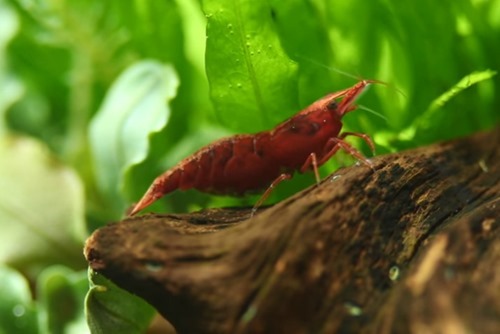
Red Cherry shrimp for sale #ad
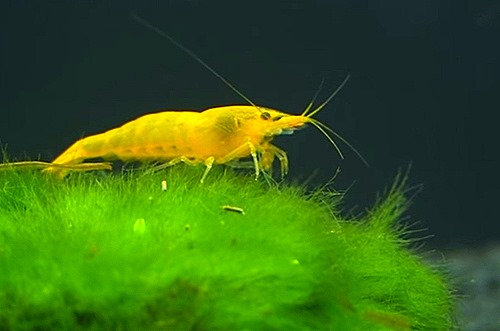
Cherry shrimp are incredibly popular with shrimp-keepers worldwide and it’s easy to see why! They’re one of the very best at algae-eating, which helps to keep your tank algae free, and they’re a beautiful bright color.
These shrimp are native to Taiwan and very easy to keep, making them highly recommended for beginners. They breed quite easily also and only grow to 1.5 inches, making it one of the smaller shrimp available. Due to their smaller size, you can keep these in a tank that’s a minimum of 5 gallons.
Amano Shrimp
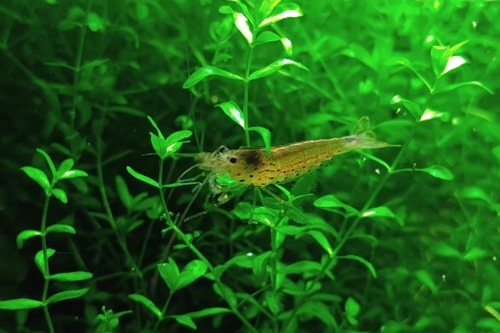
Amano shrimp are another hugely popular shrimp to keep in an aquarium. These shrimp are amazing at clearing algae, making them super effective tank cleaners. That’s not to say you shouldn’t feed them alternative foods, as they do prefer a varied diet so it is best to supplement their food with shrimp food.
These shrimp prefer lots of cover and are happiest in a planted tank that will offer lots of hiding places for them to feel safe. They grow up to 2 inches and are another shrimp that I suited for beginners. The recommended minimum tank size for Amano Shrimp is 10 gallons.
Bee shrimp – Crystal Red/Black shrimp

Bee shrimp, also called as Crystal Black/Red shrimp, aren’t as common to keep, due to their slightly more complex requirements, they’re incredibly fragile and sensitive to water change so you should only consider keeping Bee Shrimp if your water is consistently correct for what they need.
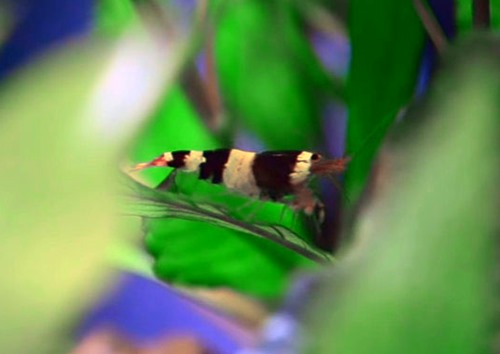
Panda shrimp are a variety of Taiwan Bee shrimp. These shrimp are so named due to their unique look. They feature black and white bandsmen resembling a panda bear – they are truly special to watch.
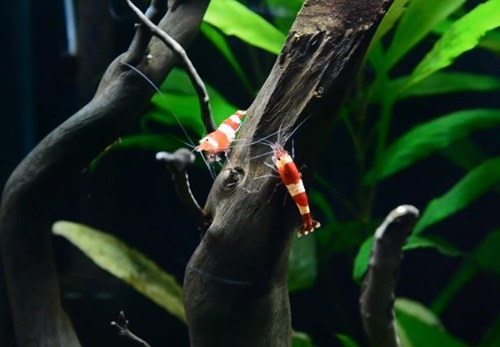
Red Panda/Red Bee/Crystal Red shrimp #ad
Bee shrimp do like to hide so plenty of cover is required in their tank. They are also best not kept with predatory tankmates as they do not have any method of defense against a hungry tankmate.
Bee shrimp grow to 1.2 inches on average and are recommended for keepers with prior experience (Intermediate). They should be kept in a minimum tank size of 5-10 gallons.
Bamboo Shrimp
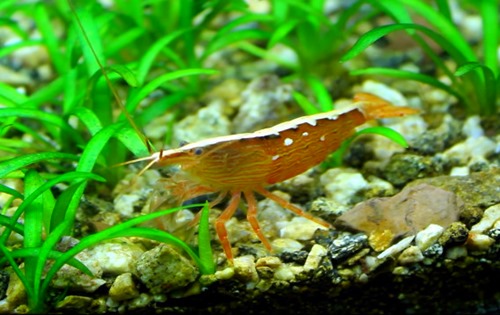
The Bamboo shrimp is one of the most common and popular shrimp you can get for your freshwater aquarium. These are native to Southeast Asia and feed by filtering the water around them; pulling microorganisms and algae from it. This is the main source of their food, they don’t usually eat algae within the tank, on décor, and suchlike, so don’t be alarmed if you don’t think you see your Bamboo Shrimp eat.
These shrimp grow to 4.5 inches, on average, and are suited for a beginner to keep as they’re easy to look after. They will molt every 45-65 days, which is something enjoyable to observe. Bamboo Shrimp can be fairly active, scurrying around the tank, and are very pleasing to sit and watch. The minimum tank size advised if you wish to keep Bamboo Shrimp is 20 gallons.
Vampire Shrimp
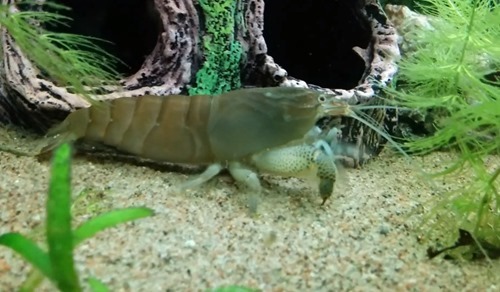
Vampire Shrimp are native to South America and Western Africa and are not a very common species of shrimp. They can live up to five years in captivity, which is far longer than most species of freshwater shrimp. The color of these shrimp can vary, from blue to gray to brown or even a pink one. They also change color frequently so makes a perfect addition of color to your tank.
These shrimp are filter feeders, they take in the nutrients they need via the water around them and don’t usually need additional food. They grow up to 2-3 inches and can be kept by beginners if research is done correctly. The minimum tank size recommended for Vampire Shrimp is 20 gallons.
Blue Velvet Shrimp
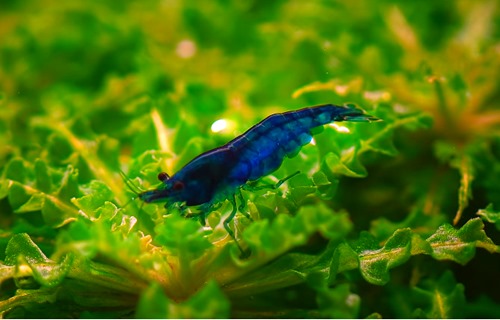
Blue Velvet Shrimp for sale #ad
Blue Velvet Shrimp are highly colorful blue shrimp, that do tend to prefer to hide away so a heavily planted tank is preferred if keeping them. Their bright color can make them look an attractive snack so hideaways are vital if you keep these with other tankmates.
These shrimp love to eat algae and will spend their time grazing on any growing in your aquarium, on décor, and such. They grow to 1.5-2 inches and can be kept by beginners in a minimum tank size of 5-10 gallons.
Blue Tiger Shrimp
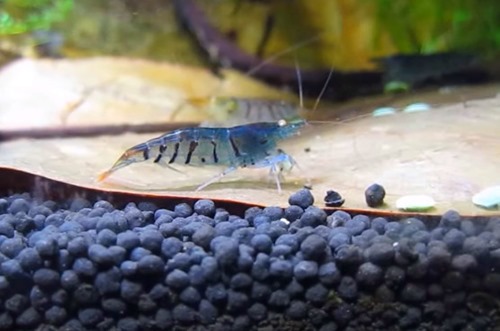
Blue Tiger Shrimp are very striking shrimp and will make a wonderful colorful addition to an aquarium. Their body is a deep blue and they have black stripes, similar to a tiger, running down their back. Their facial features are just as colorful; they have bright orange eyes and long feelers to scavenge with.
These shrimp are a little more difficult to care for, they’re sensitive to changes in the water conditions and poor water in general so they must be kept in a well-cared-for aquarium with a well-maintained filter and optimum water conditions. They grow to 1-1.2 inches and are suitable for beginners (as long as they know how to keep their water pristine) The recommended minimum tank size for Blue Tiger Shrimp is 10 gallons.
Snowball Shrimp
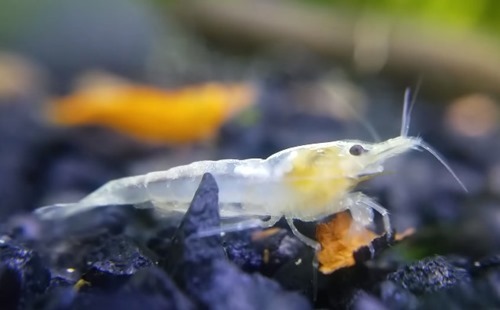
Snowball Shrimp, also known as White Pearl Shrimp, are known to be amazing for breeding. If breeding shrimp is something you’d love to give a try then the Snowball Shrimp is probably the best option for you. They breed very quickly and the eggs, which are bright white and look like snowballs, from 30 days.
These shrimp are a milky white and beautiful to watch in the tank, they grow to 1-1.5 inches and are perfect for a beginner; especially one who’s looking to begin breeding shrimp. The recommended minimum tank size for these shrimp is 5 gallons.
Ghost Shrimp
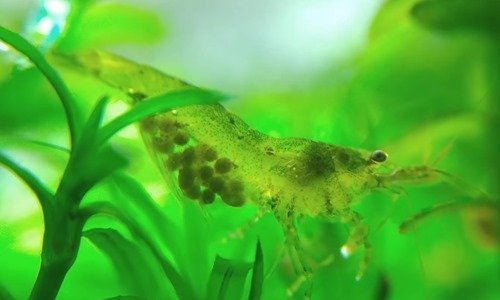
Ghost Shrimp, also known as Glass Shrimp, are beautiful to look at. They have transparent bodies that serve as a defense mechanism in the wild. They’re quite active and will often be seen moving around in the aquarium, looking for algae to eat. They’re amazing to keeping your tank clean.
These shrimp do prefer lots of cover and will be happiest in a planted tank or one with lots of wood and décor for them to tuck themselves away into. They grow to 1.5 inches and can be kept by beginners, with a minimum tank size of 5 gallons.
Indian Whisker Shrimp
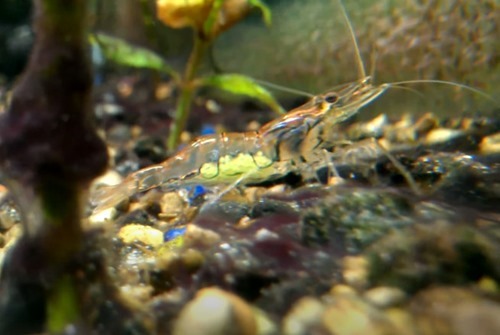
Indian Whisker Shrimp can be aggressive, which isn’t usual for a shrimp but they may take advantage of a passing smaller fish if they get the chance for an easy snack, due to their larger size. You should house them with tankmates that are not easy prey, but also that won’t see the shrimp as a tasty treat either.
These shrimp have transparent bodies and can prefer to eat leftover food that remains in the tank, they do not eat algae so you may wish to supplement their diet with shrimp food. They grow to 2 inches and are suited for beginners who know what to house them with. The minimum tank size recommended for Indian Whisker Shrimp is 5 gallons.
Pinto Shrimp
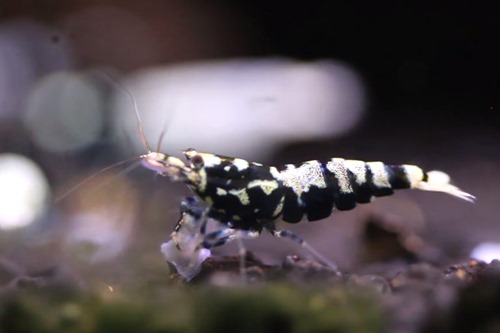
Pinto Shrimp are not one of the more common shrimp to keep, they’re quite sensitive to water changes and need stability within their aquarium. They come in shades of white and black (or red) and can make a lovely addition to any tank. They love to eat algae biofilm off décor and plants and will help to keep things clean.
These shrimp can also benefit from additional feeds of specialized shrimp food; they grow to .75-1 inches so are one of the smaller species. They can be kept by beginners and require a minimum tank size of 25 gallons.
Blue Bolt Shrimp
 10+1 Blue Bolts, Mixed Grade S-SSS #ad
10+1 Blue Bolts, Mixed Grade S-SSS #ad
Blue Bolt Shrimp are a beautiful blue and white pattern that will stand out in your aquarium, they prefer hiding places so a planted tank with hides holes is best for them. They can be quite sensitive to spikes in water so ensure your levels for ammonia and nitrite are always at 0 to keep these in perfect condition.
These shrimp grow to 1 inch and should be kept by people with some experience of shrimp-keeping (Intermediate) in a minimum tank size of 5-10 gallons.
Babaulti Shrimp
 Aquatic Arts 5 Zebra Babaulti shrimp #ad
Aquatic Arts 5 Zebra Babaulti shrimp #ad
Babaulti Shrimp are one of the easier species to look after and come in various colors. They’re more common to be seen in green but a lot are also brown. They are omnivorous so will eat algae and plant waste (detritus) to sustain themselves.
These shrimp grow to 1-1.4 inches and can be kept by beginners. The minimum recommended tank size for Babaulti Shrimp is 5 gallons.
Red Rili Shrimp
Red Rili Shrimp is another species that is quite commonly kept by shrimp-keepers, they’ve been selectively bred from Cherry Shrimp and feature a similar coloring except for having transparent patches also. They’re very easy to care for and will scavenge for waste within the tank.
These shrimp grow to 1-1.5 inches and can be kept by beginners in a minimum tank size of 5 gallons.
These are just some of the many shrimp species you can purchase for your aquarium, when choosing please take into account your water parameters and any fish or livestock you already have within your aquarium.
How to set up an aquarium for shrimp?
Shrimp tank size
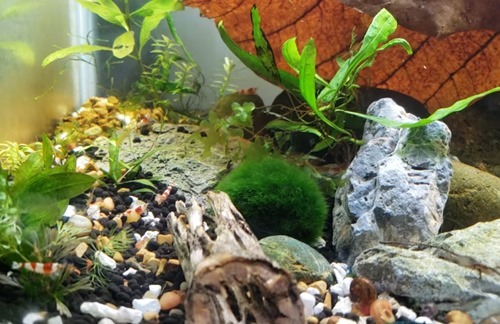
Bee shrimp planted tank with Marimo Moss Ball and Cholla wood
When keeping freshwater shrimp, you really need to have a suitable set-up in your tank for them.
Shrimp, as a general rule, tend not to grow too big (between 1 and 4 inches on average) and do far better in groups than as individuals. A 10-gallon tank is usually sufficient to keep shrimp in, with the exception of some larger species, although this depends on the quantity you intend to keep and whether you intend on adding other types of fish in with them.
A planted tank is definitely preferred when keeping shrimp, we’ll go into that in a little more depth later.
Substrate and Basic Décor
The best substrate to have in your tank would be sand, soil, or fine gravel as shrimp prefer a softer surface that they can dig into. They also find it easier to move around on a softer surface. For décor, numerous items can be used alongside shrimp, such as wood, plants, caves, and larger stones.
Shrimp will always be happier when they have a place to hide away if feeling threatened, they prefer dark and dense places where they will not be spotted by any predators. For this reason, live plants can be an ideal addition.
A planted aquarium not only provides heavy cover for shrimp to retreat to when needed but also provides an extra food source as some shrimp love feasting on moss and algae that will grow on plants as well as other decorations.
Filtration
Shrimp can be quite delicate when it comes to filtration, specifically due to their size, so if you’re running a powerful external or hang-on-back filter then you should slide a sponge or some foam over the intake tube to prevent them from being sucked in. Air-driven sponge filters can be the better choice if you aim to keep a shrimp only tank.
Heating
Some people do not need to use a heater when keeping shrimp but this will depend on the temperature of the room the aquarium is in, whether other fish are kept in there also and whether the temperature fluctuates at all. It’s best to use an aquarium heater with your shrimp as this will help to maintain a steady temperature.
You should ensure the heater is capable of holding a steady temperature, severe fluctuations can have a negative effect on any livestock in your aquarium. Having a thermometer in the water will allow you to check whether the heater is working efficiently and holding the water temperature steady.
Lighting
Lighting isn’t absolutely necessary in the aquarium if you have natural lighting coming into the room, except to view the shrimp and to help plants grow if you have a planted tank. So, for a shrimp only without plants, you can use a cheap clip-on led light without any hassles.
If you do choose to have one then a recommended amount of time to utilize the lighting would be 8-10 hours on and then a period of darkness/ just natural light from the room and surroundings.
Many shrimp keepers, especially those with planted tanks, make the most of using a timed lighting system; this ensures that the correct balance of light is used and don’t have to worry about remembering to turn it on and off.
The setup and cycle of shrimp tanks are the same as for freshwater fish. After you have collected all equipment for the setup, read our guides to aquarium setup and fishless cycle to make the tank ready for shrimp keeping.
How to care for aquarium shrimp?
Shrimp are relatively easy to care for, you simply have to ensure the water parameters are good for the species and that they have enough food; which should never be a problem as they usually always will find something edible in the tank.
Try not to worry too much if there are periods where you do not spot your shrimp in the aquarium, they can be masters at hiding away; especially if feeling threatened. Try turning the light down and adding some tasty shrimp treats to entice them out if you are particularly worried.
Water requirements
They do best in water that’s between 72˚ and 76˚ Fahrenheit, though some have a wider water temperature tolerance.
A pH of 6.5-7.0 will suit most species of freshwater shrimp but some species do prefer a slightly different range.
The water requirements for freshwater shrimp are the same for tropical freshwater fish, you should always have 0 ammonia, 0 nitrites, and below 20ppm nitrates.
GH and mineral supplement
The water condition is vital when keeping shrimp and it’s very important to understand the hardness of your water, in terms of general hardness (GH).
The general hardness measures the amount of Calcium and Magnesium that are present in the water. The lower the GH is the less of those minerals the tank has present.
This is important to know as your shrimp will molt, to molt successfully, and healthily they need Calcium Carbonate to be present in the water; this affects the hardening of their lovely new shell. Magnesium is needed to help your shrimp to absorb Calcium so it is vitally important you have both.
The optimal GH for most shrimp is 6-8 but always check your specific species to ensure it is correct.
You can monitor your GH with an aquarium test kit, you should test your water regularly in a new tank to make sure the shrimp are getting all the nutrients needed and that nothing harmful is in the water for them (ammonia, nitrites, etc.).
 Tourmaline mineral balls for shrimp #ad
Tourmaline mineral balls for shrimp #ad
You can add minerals to your shrimp tank if the GH is not enough. These can be added in many forms but ALWAYS check that what you’re adding is safe for shrimp. Most shrimp mineral supplements include Calcium, Magnesium, Iron, and Boron which all promote a healthy molt.
Shrimp foods and feeding
Choosing what to feed your shrimp should be pretty simple, depending on what species you opt to keep. Most species of shrimp will feed primarily on algae within the tank (on plants and glass and any other décor bits that collect it).
 Shrimp Food, Cholla Wood, Alder Cones and Japanese Mineral Balls #ad
Shrimp Food, Cholla Wood, Alder Cones and Japanese Mineral Balls #ad
Shrimp get a lot of nutrition from the biofilm on the surface of living or dead plant leaves, wood, or any surface submerged in the water. That is the sort of thing in their natural habitat, leaves that have fallen or been swept into the rivers in which they live. You can also add these to the aquarium. Cholla Wood, Alder Cones, Indian almond leaves, and Guava leaves tend to be good for shrimp.
 GlasGarten Bacter AE Shrimp Tank Treatment #ad
GlasGarten Bacter AE Shrimp Tank Treatment #ad
 Fluval Shrimp Granules - 1.2 Ounces #ad
Fluval Shrimp Granules - 1.2 Ounces #ad
You can also choose to supplement their diet with commercial shrimp food. The Bacter AE is one of the best shrimp foods on the market these days. This product contains dried powder of microorganisms, amino acids, and enzymes, which will enhance the formation of biofilm and provide juvenile shrimp as well as shrimplets with their favorite food. This, hence, increase the survival rate of shrimplets.
You should feed your shrimp several times a week, but not much than 5 times, based on how old your aquarium is and if it houses fish or not. Shrimp eat much more slowly than fish, so giving them the amount of food they can consume in 2-3 hours; this number is 2-3 minutes for fish.
If you have fish with shrimp, you don’t need to feed the shrimp as they also eat fish food as well. You’ll find they do an amazing job at clearing any excess fish food that may be left if you have other fish in with them. However, if your tank is new or it doesn’t have much algae for the shrimp to feed on, supplement them with their specific foods. You can occasionally feed them with blanched vegetables (Zucchini, Lettuce, Spinach, Carrots,…) but not too much.
Significant benefits of Cholla wood
Cholla wood is a great addition to aquariums that hold shrimp, this wood comes from a Cholla Cactus – when the cactus dies and dries out you get Cholla wood. It is an interesting wood as it comes in small tubes and has a cut-out pattern on it which is very different from your classic driftwood and bogwood.
Shrimp love Cholla wood as it is an incredibly soft wood that breaks down over time, resulting in a biofilm covering which shrimp love to eat. As cholla is also hollow it can also make a good place for your shrimp to tuck themselves into.
A bonus of cholla wood is that it will release tannins into your water; this can lightly stain your water yellow but it also has antibacterial and antifungal properties that can offer a boost to your tank.
You should note that adding Cholla, especially in quantities, may affect your PH by bringing it down, although smaller additions shouldn’t affect this too much.
Is Copper toxic to shrimp?
Copper ion is highly toxic to shrimp, although they do need Copper (chelated form), which is provided naturally via the food they eat or ambient water they’re in. You should never add solutions with Copper ions directly to an aquarium that holds shrimp; or indeed treatments that contain Copper.
If you have a planted tank you should also check the fertilizer/feed you use as many contain Copper – it is vital to check the labeling and ingredients of anything you add to your tank, no matter how safe you think it may be.
Can I use aquarium salt with shrimp?
Aquarium salt #ad is used by a lot of aquarium holders to help treat illness and injuries, promote a slime coat, and for general health. There are conflicting reports on whether the same can be said when using it for shrimp, generally, it is probably best to avoid salt if there’s an alternative treatment (or if the shrimp is suited to brackish water) but salt in small doses, and raised very slowly should be okay for most species; though always check the advice of the packaging or instructions before adding as aquarium salt contents can vary between brands.
How often should I do a water change if I keep shrimp?
Water changes should be done on a semi-regular basis, every 2 weeks or as needed depending on each tank’s situation; are there any issues with the water, is it cloudy, are your fish/shrimp behaving normally, do you have any other concerns?
It is best to change around 20% each time unless you have a spike of nitrates (exceed 40ppm), in which case you should change as much water as possible to dilute them before it does serious damage to your shrimp and other tank mates. The safe number for nitrate levels should not exceed 20ppm.
You can monitor the nitrate level by testing your water regularly, with a reliable water testing kit #ad, and by observing your shrimp for any abnormal behavior.
Suitable Tank Mates with Shrimp
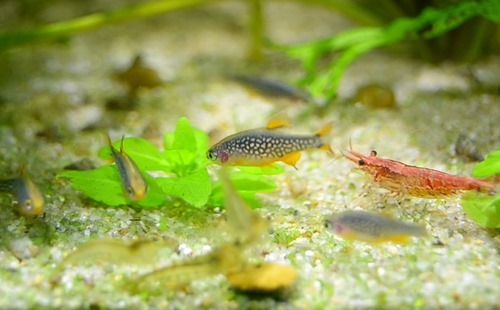
Shrimp and Celestial Pearl Danios
Shrimp can be housed with other freshwater fish but care should be taken to ensure they are compatible. You do not want any overly boisterous fish added, as a shrimp would make a very tasty snack! What types of fish are generally safe to be added with shrimp?
Betta fish can usually be housed with shrimp, some bettas can be particular to the taste of shrimp however so this can be a case of trial and error and cones down to the temperament of your betta fish, if attempting to house them together it’s best to have a backup tank on standby in case you do need to separate them.
Goldfish don’t tend to make very good tank mates either, this is due to them being a fan of shrimp as food, there are exceptions however if you opt for one of the larger shrimp species you may be able to successfully keep them together.
Safer choices that live peacefully with shrimp would be corydoras, small tetras, danios, harlequin rasboras, and any other small community fish with a small mouth. The above fish may well be the cause of baby shrimp disappearing but they shouldn’t bother older shrimp that do to fit in their mouths as easily.
Snails can also be kept with shrimp, they also help to eat waste food in the tank and can be quite the little cleaners if you’re happy having them in your tank. However, they do tend to breed very quickly and for every snail you see there’ll be at least 10 more that you don’t!
Freshwater aquarium shrimp lifespan
Most freshwater shrimp will live 1-3 years and their life cycle can be pretty interesting. An example of this is the popular Red Cherry shrimp, which is commonly kept in aquariums, this shrimp hatches from its egg after 25-35 days of being laid and look like a miniaturized version of its parents.
It then takes roughly 60 days until it is a Juvenile and only another 15 days to become an Adult; at which point it is fully grown and able to reproduce. Until the shrimp becomes a Juvenile you cannot tell what sex they are.
Breeding Freshwater shrimp

Ghost shrimp bearing eggs
If you’d like to get stuck in and breed your shrimp then some are far easier to do than others. Some will breed readily with little to no help or special changes needed and others require certain water conditions (brackish) to lay eggs so it is best to research the species information if you’d like to breed them.
In the case of Cherry shrimp, the female is ready to breed straight after molting – she will hide away and release pheromones to attract a male. Once they have bred the female will carry her eggs beneath her belly until they are ready to hatch, each batch produces 20-50 eggs. Three to five weeks after that they hatch and will eat the same food as the adults.
If you want to ensure successful breeding you can utilize a breeding box, you should ensure it has hiding places in it and that the female is added before molting so that she’s ready to breed once done. Ensure your breeding box has a fresh flow of water running through so that your shrimp remain healthy whilst going through their breeding period and that cover is provided so they do not feel threatened.
If you have other tank-mates then a breeding box is definitely needed if you wish to keep the baby shrimp and prevent them from being eaten; you can keep them in the box until large enough not to fit in tank-mates mouths, simply feed as you would the adults and ensure they have hiding places to go to so they feel safe and secure.
Shrimp Illnesses and Diseases
There are a few diseases that shrimp can be prone to, it is important you know what these are and what to look out for. Here are the most common ones that affect freshwater shrimp:
- Vorticella – this is one of the most common parasitic diseases that are found in shrimp aquariums. This will present as white moldy growth on the shrimp’s body, and may also appear on the head and nose. This disease can be mistaken for a fungal disease but it is a protozoan and needs to be treated as such; if not this can be deadly.
- Scutariella Japonica – this is a type of flatworm that infests shrimp and lives within shrimps’ gills and mantle. It can lead to death if untreated. The most common sign of this disease is a white ‘stick-like’ growth on the shrimp’s head, these are quite small and will only be 1-2 mm long. This worm lays eggs within the body of the shrimp, so that when the shrimp molts the worm’s eggs then hatch and reinfect. You can break their cycle by treating them appropriately.
- Bacterial Infections – these can be harder to diagnose and may only be considered if your shrimp seem to be dying without cause. If you have transparent shrimp however you may spot signs prior to death; in the way that the organs are displayed. If you lose a lot of shrimp with apparently no symptoms it may very well be a bacterial infection within your aquarium.
- Fungal Infections – Fungal infections can be quite common in freshwater aquariums and shrimp are quite hardy against this, due to their immune system. If you do suspect a fungal infection has broken out then there are treatments available for this.
- Parasites – there a few parasites that can infect your fish and lead to different symptoms presenting. It’s important to take note of any effects your shrimp may be showing and you can do a comparison online or via an aquarium expert to get the best advice possible.
- White Spots – If you notice spots on your shrimp at any time this can be a sign of disease; it is important to diagnose and treat promptly before it infects everything else within your aquarium.
There are numerous other diseases that can affect shrimp, the main thing to note is if your shrimp are acting oddly or have anything unusual about their appearance then it’s best to check the symptoms out in case you do have a disease or illness within your aquarium; so that you can treat it before it spreads further.
It is always best to have a stocked medicine supply, ensuring that each medication is safe for shrimp. It’s better to have it and not need it then need it and not have it!
If you do need to medicate the tank check and recheck the dosage needed, ensure it is shrimp-safe and if you have any carbon in your filter remove it prior to medicating the tank. This step is important as carbon can soak up the medicine rendering it neutral so you should always check your filtration material before medicating – just in case!
You should usually avoid water changes until treatment is finished (unless the medication instructions advise otherwise) and carbon can be re-added (if needed) once the treatment course is complete.
What shrimp for a beginner tank?

We’ve previously mentioned there are numerous shrimp species to choose from. The most common that people tend to keep in their aquarium are as follows:
- Cherry Shrimp – Suited for beginners and grow to 1.5″
- Ghost Shrimp – Suited for beginners and grow to 1.5″
- Amano Shrimp – Suited for beginners and grow to 2″
The examples above are all great choices to get started with if you’re a shrimp novice. They’re all readily available to purchase, and as they’re really popular to keep, a wealth of information can be found online in relation to their care and help with illness/diseases if you need it.
All of the above can also be housed in 5-10-gallon tanks and upwards so they are perfect choices if you’re starting with a smaller aquarium.
Where can I get aquarium shrimp?
[ad]
You can buy aquarium shrimp from a variety of places. Amazon has a very good variety available and you can also stock up on all the extras you require to keep shrimp from there also.
Buying livestock from Amazon is completely safe, they transport the shrimp well and securely. Return to the ‘types of aquarium shrimp‘ sections.

 Aqua Huna Red Rili Shrimp #ad
Aqua Huna Red Rili Shrimp #ad Marimo Moss Ball #ad
Marimo Moss Ball #ad 5 pieces of Cholla wood #ad
5 pieces of Cholla wood #ad AZOO Mignon HOB filter #ad
AZOO Mignon HOB filter #ad Sponge filter #ad
Sponge filter #ad API GH & KH test kit #ad
API GH & KH test kit #ad API 5-in-1 test strips #ad
API 5-in-1 test strips #ad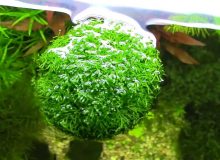
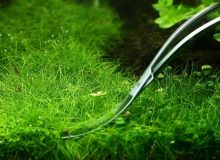


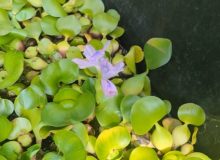

Leave a Reply